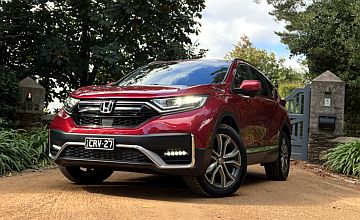2023 Honda CR-V VTi-LX AWD Review

Overview
HONDA last updated the CR-V for the 2021 model year, added refreshed styling, more standard equipment, and improved safety technology across the range.
The model underwent a mild price hike at the same time but is still one of the more affordable contenders in the SUV range – something that is bound to change when the new model arrives within the next 12-18 months, assuming the latest Civic and HR-V are anything to go by.
Which is one of the reasons this look back at one of Honda’s favourites is so important. Making that decision to “pull the trigger” on the current model could save you thousands of dollars – while also placing you behind the ‘wheel of an eminently practical and liveable mid-size SUV.
The CR-V range begins at $30,490 and tops out at $47,490 for the VTi-LX all-wheel drive (AWD) on test.
Honda’s most recent update endowed the CR-V with new bumpers and grille, dark-tinted tail-light lenses, and dark chrome garnishing. Ignite Red paint, as pictured, also joined the ranks back in 2021, alongside Cosmic Blue.
As before, the base model Vi is powered by a 2.0-litre four-cylinder petrol engine – the only naturally aspirated mill in the range – good for 113kW of power and 189Nm of torque, all sent to the front wheels via a continuously variable transmission (CVT).
Higher trim lines score a 140kW/240Nm turbocharged 1.5-litre four-cylinder powerplant with drive sent to either the front or all four wheels – depending on the variant – via the same CVT as the base model.
There is also a long list of amenity and technology goodies offered for the price including heated leather seats, 17-inch alloys, Apple CarPlay and Android Auto, wireless phone charging, dual-zone climate control, a tilt and slide panoramic sunroof, reversing camera, electric park brake, Bluetooth phone and audio streaming, tyre-pressure monitoring, LED headlights and a handsfree powered tailgate.
Importantly, higher grade CR-Vs also include the Honda Sensing safety suite with forward collision warning, collision mitigation braking, lane keep assist, road departure mitigation and adaptive cruise control. The Honda CR-V scored a five-star ANCAP safety rating when last assessed in 2017.
Driving Impressions
It is really nice to spend time with a current generation vehicle ahead of the arrival of its successor – especially when that vehicle is a relevant and steady seller with a lot left to offer buyers.
Despite its age, the CR-V VTi-LX AWD on test is still a stylish vehicle that shows a quality of assembly many in its segment lack … though arguably there are elements of the cabin that lack the ‘modern look’ we have come to expect. There is a noticeable absence of wide screen monitors and touchscreen controls inside the CR-V.
Though that is not altogether a bad thing – and when you consider the amenity and practicality the CR-V offers its occupants, we think few buyers will happily make the compromise.
The CR-V offers a useful cargo area with fold-flat seating that is perfect for the occasional trip to the Big Green Shed or that Swedish furniture company. It is a theme that continues elsewhere in the cabin where flexible and generous storage abounds, as if the designers really cued into the way family buyers use their mid-size SUV … let’s hope this degree of pragmatism continues in the new model.
Considering its design age, the CR-V is a very well pieced together vehicle that is free of rattles and squeaks, the only noises of any note in the cabin coming from the road and tyres when travelling at highway speeds. It is spacious and offers comfortable seating for longer stints at the ‘wheel – and what we firmly believe is one of the best hip points in the segment.
Honda’s 1.5-litre mill does a decent job of hauling the car down the road, but we reckon the 2.0-litre VTEC Turbo unit would be better again. Still, the continuously variable transmission is well matched to the engine’s torque band and is quick to react when climbing hills or pulling out to overtake.
We sampled the CR-V over our usual mix of urban and peri-urban roads, taking in busy commuter traffic and meandering back roads to test not only the vehicle’s performance and fuel economy – which averaged 8.4 litres per 100km – but also its dynamic capabilities and ride comfort.
And we have to say the ride comfort of the CR-V is very good – especially when viewed against some of the “sportier tuned” offerings that now pose as family transport. On the lumpy roads of the Macedon Ranges the Honda’s suspension maintained its composure well, cornering with confidence and never fumbling for grip.
That said, you can hear the suspension working when it is really put to the test, though we think most buyers will be smart enough to separate the aural input against that from the steering wheel and the seat of their pants.
But perhaps it is those drivers – or buyers cross-shopping the CR-V against its newer contemporaries – that will recognise the lack of finesse the steering and pedal box offers. The CR-V doesn’t quite have the speed and fluidity of response found elsewhere in the line-up, and although it does steer well, you will have to work for your reward.
There is road feel to be found, but it is more subdued than we have experience in more modern EAPS setups. If a polished and ultimately more accurate steering SUV is on your shopping list, then perhaps the next-generation CR-V will be a better choice for you.
However, if you’re looking to snap up a reliable and robust family hauler that is virtually guaranteed to provide you with years of trouble-free motoring, then it is worth adding the CR-V to next weekend’s test drive list – especially if function takes priority in your busy lifestyle.